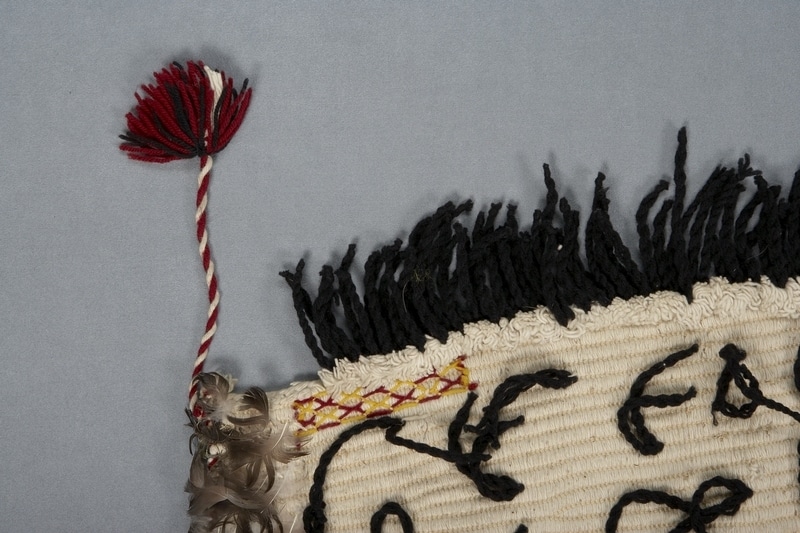Cape Item Number: 1711/1 from the MOA: University of British Columbia


Description
Feather trimmed cape. Cape has a natural beige background and is decorated with coloured designs, black yarn and feathers. There are rows of rectangular designs filled with cross-hatching in either red/black or red/yellow. There are many pieces of black yarn sewn down at one end with the other end hanging loose. The sides and bottom of the cape have a grey-brown feather fringe. The top of the cape has a black multi-strand fringe. Each top corner has a red and white twisted fibre with an ornamental red tuft.
Specific Techniques
The yarn used for weaving is either candle wick or mop cloth. The feather border is composed primarily of wild turkey (Meleagris gallopavo) body (covert) feathers. Wild turkeys are not native to New Zealand but feral flocks exist. Morphologically, it is not possible to determine if these are from a domestic or feral bird. The cape has four non-turkey feathers, which may be “weaver signature feathers”. The two non-pennaceous golden brown feathers, with a darker core near the shaft, are Weka (Galliralliu australis), a New Zealand indigenous species of flightless rail. The badly damaged feather with the green iridescent outer border of the outer vane and gray inner vane is the indigenous New Zealand pigeon (Hemiphaga novaeseelandiae). The completely white feather may also be from the New Zealand pigeon.
Narrative
The cape was said to have been collected by Barley c. 1900, however the fact that the cape is made from cotton instead of New Zealand flax fibre suggests a later date, such as c. 1950. Aotearoa is the Maori name for New Zealand.
Item History
- Made in New Zealand during 1950
- Owned by Albert Barley
- Owned by Tom Beesley and Laverne Beesley before August 19, 1994
- Received from Laverne Beesley (Donor) and Tom Beesley (Donor) on August 19, 1994
What
- Name
- Cape
- Identification Number
- 1711/1
- Type of Item
- cape
- Material
- wild turkey feather, cotton fibre, new zealand pigeon feather and weka feather
- Overall
- height 130.0 cm, width 105.0 cm
Who
- Culture
- Maori
- Previous Owner
- Albert Barley, Tom Beesley and Laverne Beesley
- Received from
- Laverne Beesley (Donor) and Tom Beesley (Donor)
Where
- Holding Institution
- MOA: University of British Columbia
- Made in
- New Zealand
When
- Creation Date
- during 1950
- Ownership Date
- before August 19, 1994
- Acquisition Date
- on August 19, 1994
Other
- Item Classes
- textiles
- Condition
- good
- Accession Number
- 1711/0001